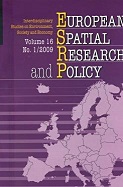Types and Systems of Actors in Regional Development: Their Function and Regulatory Potential
Types and Systems of Actors in Regional Development: Their Function and Regulatory Potential
Author(s): Jiří Blažek, Martin HamplSubject(s): Social Sciences
Published by: Wydawnictwo Uniwersytetu Łódzkiego
Keywords: regional development actors; balances versus asymmetric systems; social capital; developed countries; global system
Summary/Abstract: The evaluation of the actors in regional development is only one component/level within the regional research. However, it is a level which increases its significance and has or could have the key role in the sphere of regional development and at the same time reflects the problems on other levels. It is in fact the proportionality and balance of the whole system that determines the resulting effects of activities and regulatory competence of actors. If there is an imbalance – even an asymmetry – in this system, advocacy of only certain interests becomes understandably imminent, as well as a reduction of interactions (not only) in the organisation of regional society. Differentiation of actors derives primarily from the distribution of power and wealth in a society, and thus it has always played an exceptionally significant role. However, as a consequence of the hierarchical organisation of the society this differentiation was noticeably asymmetrical. The non-equivalence of partial subjects/actors of regional development has led to the understandable domination of ‘deterministic’ relations and the plurality of interests and then to the dominance of ‘competitive’ relations. Only gradually do interactions of a cooperative kind successively break through the growth of mutual interconnections, linkages and necessity of social elements and partial systems, and thus the increasing of organic nature of (geo)societal systems. This will be finally illustrated through the difference between ‘symmetric’ systems of actors in developed countries and the ‘asymmetric’ global system.
Journal: European Spatial Research and Policy
- Issue Year: 16/2009
- Issue No: 1
- Page Range: 75-92
- Page Count: 18
- Language: English

